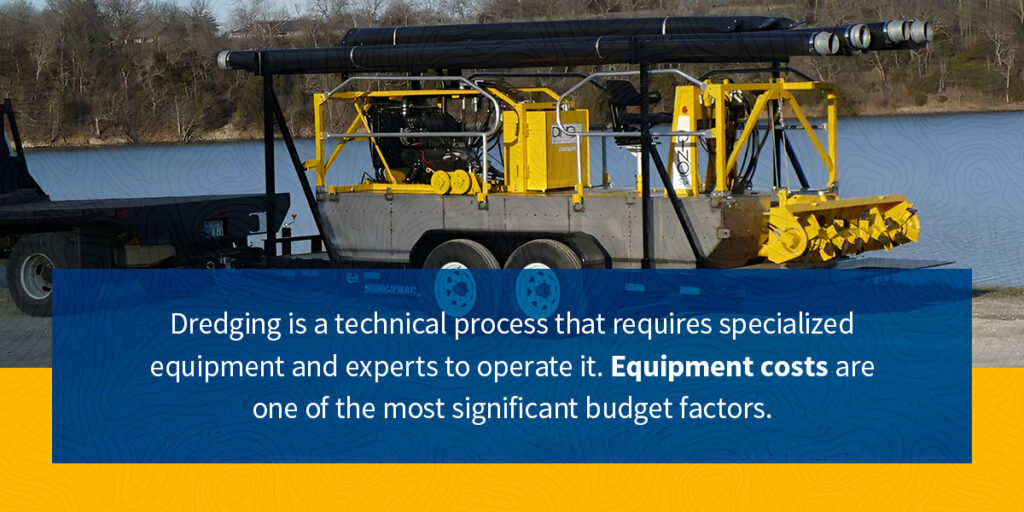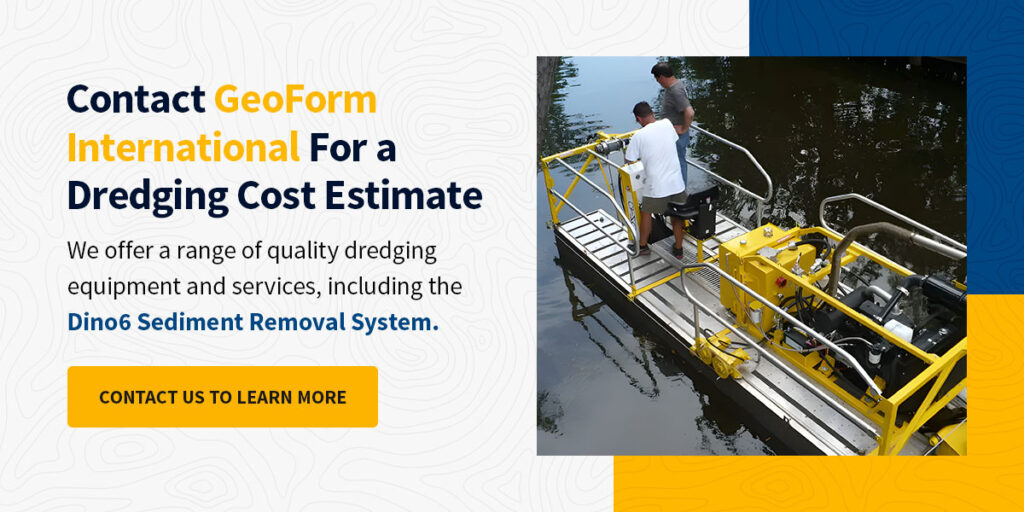Dredging is a way of excavating sediments from bodies of water using specialized equipment. If you maintain water bodies like ponds or lakes, dredging becomes an essential part of preserving your property — whether you have private or municipal ownership, are part of a homeowners association or manage a golf course.
Dredging goes beyond simply cleaning up for the appearance of your water body — it improves water quality and depth, which can help keep ecosystems healthy and maintain your property’s value.
Every dredging project is unique, and several factors will affect the price. To work out the cost of dredging, you need to consider the type of project, the equipment you need, overheads and several other expenses. Hence, you will not get a hard and fast number for how much dredging costs until you consult with industry professionals. However, you can get an idea of the factors you must consider that will affect the cost of your dredging project.
Factors That Impact The Cost of Dredging
Dredging costs are highly variable and will depend on your project’s needs. Consider these factors to get an idea of what to include when you start drawing up your budget:
Dredging Specifics
Project specifics range from the type of dredging you need to do and the length of your project to the location of your waterbody and the kind of sediment you need to remove. Include as many variables as possible when you map out your costs for the most accurate projection.
Type of Dredging Project
The first consideration when calculating dredging costs is the type of project you are working on. Lake dredging costs will differ from cleaning canals, land reclamation projects or expanding ports. More extensive projects, such as land reclamation or deepening waterways for cargo ships, will cost more. However, these are also the projects that are generally government-funded or tended — at least partly.
Sediments and Dewatering
How much material you need to remove and the type and quantity of the sediment are significant factors in how much your project will cost. Surveyors will use a technique called bathymetric mapping to reveal a waterbody’s depth and volume accurately and to get an idea of how much sediment you will need to remove. If the sediment is very deep, your costs will go up.
Viscous materials are easier to dredge from waterbodies, so dredging costs will also increase if the sediment is very watery, as experts must use specialized equipment to dewater the sediment first. The dewatering process can take anywhere from a few days to a few months, depending on how much material must be removed and the composition of the sediment.
Another consideration is discovering invasive plants or species in your waterbody — you will need to factor in the costs of consulting with environmentalists to stop the spread of invasive species and adequately manage the ecosystem.

Equipment
Dredging is a technical process that requires specialized equipment and experts to operate it. Equipment costs are one of the most significant budget factors:
- Types of dredges: The two primary types of dredges are mechanical and hydraulic. Mechanical dredges remove sediment using buckets and transfer it to trucks or barges. Hydraulic dredges use rotating underwater cutters and pumps to extract sediment and move the material to the disposable site with a floating pipeline. Mechanical dredges can handle larger dredge materials, but hydraulic dredges can remove large volumes of material in short periods. Hydraulic dredges generally cost less to purchase, operate and maintain than mechanical dredges.
- Buying a dredge: Your costs will work out quite differently depending on if you are renting or buying a dredger. Purchasing a dredger is an investment that will save you in the long term, but this may only make sense for you if you are a property owner. If you are overseeing a municipal project, renting a dredger as needed could be the more cost-effective solution.
- Operating a dredge and run time: The cost of using the equipment is an essential factor. You must employ a small group of highly skilled professionals to use the dredge and oversee the site and the project. Also, factor in how long your project will take.
Accessibility
The less accessible your waterbody is, the more that will factor into your costs. For example, if the waterbody is surrounded by residential or protected property, you may need to pump the sediment several thousand feet away from the site. In this case, you will need large specialized pumps, impacting your budget.
Trucking costs will also be higher if the waterbody is less accessible if you need to haul materials offsite.
Permits
While technology, equipment and the dredging industry as a whole continue to advance, there can be environmental impacts from dredging. Depending on where you intend to dredge, you may need a permit to get started. Getting to and from the dredging site can impact the surroundings, and the sludge that is extracted, as well as disposing of it, may be hazardous. Consulting the appropriate environmental firms and obtaining required permits may add to your project’s costs.
Disposal
Disposing of dredged sludge can be a complex process. For safety and environmental reasons, regulations govern where and how to dispose of the sediment. In some instances, you may need to send sediment off for testing to determine the composition of the contaminants. If the lab deems the sediment hazardous, you must dump it according to regulations on disposing of hazardous waste, and the landfill may impose extra charges.
Other Expenses
When planning your budget, consider these miscellaneous expenses related to dredging:
- Fuel: Diesel engines power many dredges, so you need to include the cost of fuel for your dredge and trucks if you are hauling materials offsite.
- Downtime: Dredging may interrupt certain operations at an estate, and you will need to factor downtime into your costs.
- Consultation fees: Getting started isn’t as easy as simply asking one expert what dredging a pond costs. The scope of dredging projects is often much broader than first imagined, and you may need to consult with various industry professionals — from equipment operators and lawyers to surveyors, lab consultants and environmentalists.
Contact GeoForm International For a Dredging Cost Estimate
Are you reading to start your dredging project? Though working out the costs involves various details, it is possible to get a comprehensive cost estimate by consulting with industry experts. You can rely on our skilled team at GeoForm International Inc. to understand the specifics of your project and provide you with industry-leading dredging equipment for your needs.
We offer a range of quality dredging equipment and services, including the Dino6 Sediment Removal System. At a little over 22 feet long, 6 feet wide and less than 6 feet tall, the Dino6 Sediment Removal System is a portable but powerful hydraulic dredge, ideal for inaccessible projects that may otherwise have been complicated or costly. The dredge also features a 6-inch submersible pump, 66-inch-wide cutterhead and a four-cylinder diesel engine. Contact GeoForm International to learn more about a dredging cost estimate, the option to rent or buy, and our Dino6 dredge and submersible pumps!

